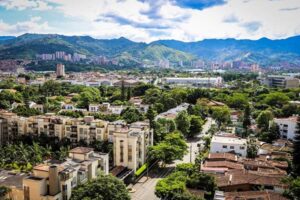You’re looking at buying a condo in Latin America…perhaps in Panama City or in Medellín, Colombia. Your agent has shown you a brand-new, two-bed condo in a glitzy high-rise block. It’s got a gourmet kitchen and a spa-like master bathroom.
But you know from your research that the older building right next door has two-bed condos for half the price. Sure, they’re dated—but you’ll have plenty of cash left over to do a custom remodel.
Why such a huge difference in price?
One reason is that Latin buyers typically want new and shiny. They’re happy to pay more for the latest finishes and up to date style.
But there are some other reasons why older condos sell for so much less…
Let’s start with the two biggest upsides of buying an older condo.
First, there’s the value. Older condos are a good way to buy a home in a desirable area if you’re on a tight budget. Or you can simply bag a much bigger condo. I’ve seen an older condo with more than 2,000 square feet of living space listed at the same price as a brand-new condo with only 1,000 square feet next door to each other in Panama. The older condo had marble floors, hardwood cabinetry, and the same ocean views as its much pricier (albeit newer) neighbor.
Older condos are often in prime locations. We all know that when buying property, location is key. An older condo may give you the opportunity to own a condo in a prime city center location where you can walk to shopping, eateries, work, and entertainment. You see this in Medellín where newer buildings are often in more marginal locations, where you’ll need a car.
So what’s the trade-off? Older condos will likely need a remodel. Kitchen and bathroom fittings may look very dated. You might not get an open-plan layout or nice finishes. You need to calculate how much a remodel will cost—and if it will add value.
Then there’s the parts you can’t change. The social areas in newer condo buildings are generally much fancier, with state-of-the-art gyms, party rooms, hot tubs, and mini movie theaters. The lobby can look like a luxury hotel. Older buildings sometimes don’t even feature so much as a swimming pool.

But there are two major downsides that frequently crop up with older condos that you need to watch out for.
The first is the costs. In condo buildings, there are monthly fees that go toward cleaning and maintenance of the common areas of the condo building. They pay the salary of security staff, caretakers, and administrators. The monthly fee should also include a sum that’s paid into a reserve fund. That reserve fund is there for a rainy day—if the entire roof on the building needs replacing, the elevator breaks down or the sprinkler system needs updating. This is much more likely to happen in an older building.
In Latin America, owners often try to cut their monthly condo or association fees to the bone. They pay enough to fund day-to-day expenses like the security guard’s salary or cleaning the hallways. But there’s nothing left over for the reserve fund. And when a big-ticket expense crops up, many owners don’t want to pay for it.
I’ve stood in line in an older building with only one working elevator. The other two needed major repairs and the majority of owners either didn’t want to pay for it or simply couldn’t afford to do so due to divorce, unemployment, or a lack of savings.
And I’ve heard horror stories of “special assessment” bills of $80,000 per condo to fix major faults…because owners hadn’t paid into a reserve fund for years.
You should always ask to see the building’s accounts if you’re buying a condo. Look at this year’s budget, how much owners will pay per month, what it covers and what it’s spent on. Ask to see projections for next year. Ask if there is a reserve fund and how well-funded it is.
Find out if there are any planned special assessment bills coming up to cover big-ticket expenses like replacing a roof or the elevators. Special assessments are charged when there isn’t enough money in the reserve fund to cover the cost of major works or repairs. A friend bought a condo and didn’t ask about any scheduled special assessments. Months after he moved in, he was hit with a bill for $25,000 to replace the roof. It was all there in the paperwork—but he hadn’t reviewed it.
Look at the set-up of the condo association, who decides how much owners will pay per month and how it’s allocated. Check if there’s a schedule of ongoing maintenance and running repairs. And always find out what options owners have if they disagree with the cost of monthly fees or special assessments.
The second important fact you need to know with older condos is that they may not qualify for bank financing. In much of Latin America, banks often won’t offer mortgages on older condos. Once the condo is more than 20 years old, the loan to value the banks will offer starts to fall. By the time the condo is 30 years old, fewer banks will want to offer finance…and those that do will offer a much lower loan to value. Once the condo is 40 years old, finding any kind of bank finance is almost impossible.
You may not think that matters if you’ve got the cash to buy. But if you decide to sell the condo at a later date, you’ll have to find another cash buyer. That means a much smaller pool of potential buyers. This is the main reason you’ll come across older condos at bargain prices.
Get Your Free Real Estate Report Now
Sign up for our free daily Postcard e-letter and get a valuable free report on the The 5 Best Places to Buy Real Estate In 2023.
Related Articles
Property Bargains From $80,000 in These Three South of France Gems
Dream Homes in Italy from $76,617
Upcoming Conferences
Most Popular Products
Panama 101
Portugal 101
Costa Rica 101



